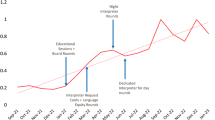Abstract
Prior research has documented that medical interpreters engage in non-conduit roles during medical visits. However, agreement on the appropriateness of these roles and their impact on the medical encounter have not yet been achieved. The purpose of this study was to identify non-conduit behavior (role exchange), elucidate the various forms it takes among different types of interpreters, and assess its potential to affect clinical encounters. Using audiotapes from 13 pediatric outpatient visits, we found that “chance” and uncertified hospital interpreters engaged in role exchange by assuming the provider’s role; the patient’s role; and taking other non-interpretive roles such as socializing with mothers or acting in one’s alternate professional role. These behaviors occurred frequently among both types of interpreters while the provider was actively engaged in conducting the medical visit. In most instances, the interpreter did not make his or her behavior transparent to either the provider or the mother. Implications for interpreter and provider training are discussed.
Similar content being viewed by others
References
US Bureau of the Census. Language use and English speaking ability: 2000, 2003. Available from: www.census.gov/prod/2003pubs/c2kbr-29.pdf. Accessed June 2006.
Flores G, Abreu M, Olivar MA, Kastner B. Access barriers to health care for Latino children. Arch Pediatr Adolesc Med. 1998;152(11):1119–25. November.
Flores G, Abreu M, Tomany-Korman SC. Limited English proficiency, primary language at home, and disparities in children’s health care: how language barriers are measured matters. Public Health Rep. 2005;120(4):418–30. July.
Yu SM, Nyman RM, Kogan MD, Huang ZJ. Schwalberg RH. Parent’s language of interview and access to care for children with special health care needs. Ambul Pediatr. 2004;4(2):181–7. March.
Flores G. The impact of medical interpreter services on the quality of health care: a systematic review. Med Care Res Rev. 2005;62(3):255–99. June.
Karliner LS, Jacobs EA, Chen AH, Mutha S. Do professional interpreters improve clinical care for patients with limited English proficiency? A systematic review of the literature. Health Serv Res. 2007;42(2):727–54. April.
Dysart-Gale D. Communication models, professionalization and the work of medical interpreters. Health Commun. 2005;17(1):91–103.
Hsieh E. Interpreters as co-diagnosticians: overlapping roles and services between providers and interpreters. Soc Sci Med. 2007;64(4):924–37. February.
Kaufert JM, Putsch RW. Communication through interpreters in healthcare: ethical dilemmas arising from differences in class, culture, language and power. J Clin Ethics. 1997;8(1):88–93.
Beltran Avery MP. The role of the health care intepreter: an evolving dialogue. National Council on Interpreting in Health Care Working Paper Series. Santa Rosa, California. 2001.Available from: www.ncihc.org/workingpapers.htm. Accessed August 2006.
Hsieh E. Conflicts in how interpreters manage their roles in provider-patient interactions. Soc Sci Med. 2006;62(3):721–30. February.
Norris WM, Wenrich MD, Nielsen EL, Treece PD, Jackson JC, Curtis JR. Communication about end-of-life care between language-discordant patients and clinicians: insights from medical interpreters. J Palliat Med. 2005;8(5):1016–24.
Baker DW, Hayes R, Fortier JP. Interpreter use and satisfaction with interpersonal aspects of care for Spanish-speaking patients. Med Care. 1998;36(10):1461–70. October.
Elderkin-Thompson V, Silver RC, Waitzkin H. When nurses double as interpreters: a study of Spanish-speaking patients in a US primary care setting. Soc Sci Med. 2001;52(9):1343–58. May.
Flores G, Laws MB, Mayo SJ, Zuckerman B, Abreu M, Medina L, et al. Errors in medical interpretation and their potential clinical consequences in pediatric encounters. Pediatrics. 2003;111(1):6–14. January.
Rivadeneyra R, Elderkin-Thompson V, Silver RC, Waitzkin H. Patient centeredness in medical encounters requiring an interpreter. Am J Med. 2000;108(6):470–4. April 15.
Bolden GB. Toward understanding practices of medical interpreting: interpreters’ involvement in history taking. Discourse Studies. 2000;2(4):387–419.
Davidson B. Questions in cross-linguistic medical encounters: the role of the hospital interpreter. Anthropol Q. 2001;74:170–8.
Leanza Y. Roles of community interpreters in pediatrics as seen by interpreters, physicians, and researchers. Interpreting. 2005;7(2):167–92.
Preloran HM, Browner CH, Lieber E. Impact of interpreters’ approach on Latinas’ use of amniocentesis. Health Educ Behav. 2005;32(5):599–612. October.
Vasquez C, Javier RA. The problem with interpreters: communicating with Spanish-speaking patients. Hosp Community Psychiatry. 1991;42(2):163–5. February.
Laws MB, Heckscher R, Mayo SJ, Li W, Wilson IB. A new method for evaluating the quality of medical interpretation. Med Care. 2004;42(1):71–80. January.
Hsieh E. Understanding medical interpreters: reconceptualizing bilingual health communication. Health Commun. 2006;20(2):177–86.
Diversity Rx. Models and practices: Choosing a Role. Available from: www.diversityrx.org/HTML/MOIPR3.htm. Accessed May 2008.
Hatton DC, Webb T. Information transmission in bilingual, bicultural contexts: a field study of community health nurses and interpreters. J Community Health Nurs. 1993;10(3):137–47.
Stein LI. The doctor-nurse game. Arch Gen Psychiatry. 1967;16(6):699–703. June.
Author information
Authors and Affiliations
Corresponding author
Rights and permissions
About this article
Cite this article
White, K., Laws, M.B. Role Exchange in Medical Interpretation. J Immigrant Minority Health 11, 482–493 (2009). https://doi.org/10.1007/s10903-008-9202-y
Received:
Accepted:
Published:
Issue Date:
DOI: https://doi.org/10.1007/s10903-008-9202-y



